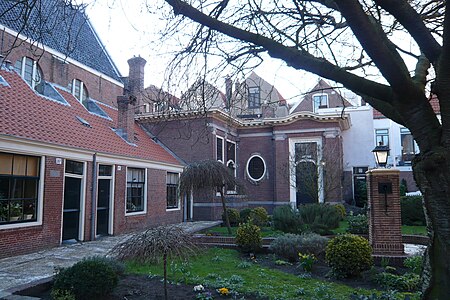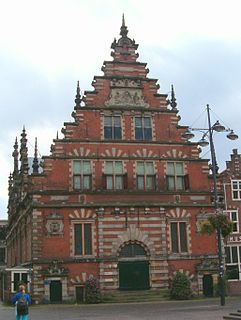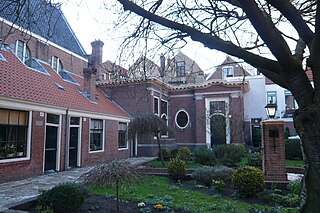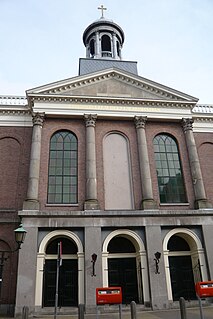
The Lutherse kerk in Haarlem is a Lutheran church dating from the 17th century on the Witte Herenstraat in Haarlem, Netherlands.

The Lutherse kerk in Haarlem is a Lutheran church dating from the 17th century on the Witte Herenstraat in Haarlem, Netherlands.


The Lutheran church was built in 1615 on the site of the older "Witte Heren" monastery (named after the white religious habit of the monks) that itself was demolished after the Protestant reformation of the 16th century. [1] In the second half of the 19th century a new facade was built. [1] The French mechanical clock in the tower is from 1892. [1] The organ was built in 1882 by Julius Strobel to replace a Gideon Bätz organ made in 1790. [1]
The church was originally a clandestine church, hidden from view, but today can easily be seen from the street.

Haarlem is a city and municipality in the Netherlands. It is the capital of the province of North Holland. Haarlem is situated at the northern edge of the Randstad, one of the most populated metropolitan areas in Europe; it is also part of the Amsterdam metropolitan area. Haarlem had a population of 161,265 in 2019.

St Anne and St Agnes is a church located at Gresham Street in the City of London, near the Barbican. While St Anne's is an Anglican foundation, from 1966 to 2013 it was let to a congregation of the Lutheran Church in Great Britain.

The Grote Kerk or St.-Bavokerk is a Reformed Protestant church and former Catholic cathedral located on the central market square in the Dutch city of Haarlem. Another Haarlem church called the Cathedral of Saint Bavo now serves as the main cathedral for the Roman Catholic Diocese of Haarlem-Amsterdam.

De Adriaan is a windmill in the Netherlands that burnt down in 1932 and was rebuilt in 2002. The original windmill dates from 1779 and the mill has been a distinctive part of the skyline of Haarlem for centuries.

The Vleeshal is a historical building dating from 1603 on the Grote Markt in Haarlem, the Netherlands.

The Lutherse Hofje is a hofje in Haarlem, Netherlands.

The Zuiderhofje is a hofje in Haarlem, Netherlands.

The Grote Markt is the central market square of Haarlem, Netherlands.

The Holy Trinity Church, also known as Zug's Protestant Church, is a Lutheran church in central Warsaw, Poland, and one of two Augsburg Evangelical temples in the city. Designed by Szymon Bogumił Zug, it is one of the largest churches in Warsaw and one of the most notable for its round design.

Budolfi Church is the cathedral church for the Lutheran Diocese of Aalborg in north Jutland, Denmark.

The Hofje van Codde en Beresteyn is a hofje in Haarlem, Netherlands. The current building is from 1968 and is located on the J. Cuyperstraat, which is named for the architect who designed the Cathedral of Saint Bavo next door, Joseph Cuypers. This hofje is the wealthiest hofje foundation in Haarlem with the most modern facilities for its inhabitants. Poor (devote) Catholic women of Haarlem 60 years and older are still welcome to live there for free.

The Nieuwe Kerk is a church in The Hague, located across from the modern city hall on the Spui. It was built in 1649 after the Great Church had become too small. Construction was completed in 1656.

The Waalse kerk is a historical church dating from the 14th century on the Begijnhof in Haarlem, Netherlands.

The St. Joseph kerk is a church dating from the 19th century on the Jansstraat in Haarlem, Netherlands. It is located across from the Janskerk (Haarlem).

The Doopsgezinde kerk is a historical hidden Mennonite church dating from the 17th century between the Grote Houtstraat, Peuzelaarsteeg and the Frankestraat in Haarlem, Netherlands.

The church St. Gumbertus is one of the central city churches of Ansbach, Bavaria, together with the neighboring St. Johannis. Located in the Altstadt of Ansbach, St. Gumbertus, now a Lutheran church, was originally the church of a monastery that was founded by St. Gumbert around 750. Today it serves as a venue for concerts of the music festival Bachwoche Ansbach. The church contains the oldest structures in Ansbach and is considered Ansbach's city symbol.

Christian Müller was a Dutch organ builder, born in the Lower Saxony part of Germany. He is renowned for building the great organ in the Grote Kerk, Haarlem, which at the time was deemed as the largest organ in the world; its reputation has been amplified by the fact that several composers have performed on it over the centuries, including Georg Friedrich Handel and Wolfgang Amadeus Mozart.

The Nieuwe Kerk is a historical Protestant Reformed church dating from the 17th century on the Nieuwe Kerksplein in Haarlem, Netherlands.

The Coomanshof is a former hofje in Haarlem, Netherlands, on the Witte Heren straat.

A swallow's nest organ is a form of pipe organ which takes its name from its resemblance to the nests built by swallows. Rather than placed on a gallery or on the floor, the swallow's nest organ case sits on a platform suspended on a wall, with the wall as its sole support. In some churches it was wedged into the triforium. In swallow's nest organs from the Renaissance period, the base of the suspended platform, called a tribuna, typically tapered into a point. There is generally only room in a swallow's nest for one person, the organist, who accesses it by a ladder or from a staircase concealed behind the wall.
| Wikimedia Commons has media related to Lutherse Kerk, Haarlem . |
| Dutch Rijksmonument 19616 |